
by Kosher Casual Team | Jul 14, 2024 | Body Type, modest clothing, Uncategorized
Dress for Your Body Type!
Women’s body types are commonly categorized into several shapes based on the distribution of body fat and muscle. Embracing and feeling confident with your body type shape is crucial for self-esteem and well-being. Understand that bodies come in all shapes and sizes, and beauty is diverse. Here are some tips to help you understand your body type and dress more confidently:
- Pear (Triangle) Body Type:
- Characteristics: Hips are wider than shoulders; fuller hips and thighs; narrower waist; smaller bust.
- Styling Tips: Emphasize the upper body with bright colors and patterns; wear darker colors on the bottom; A-line skirts and Fit and Flare dresses are flattering; balance the proportions with structured tops.
- Apple (Round or Oval) Body Type:
- Characteristics: Weight is concentrated around the midsection; fuller bust; narrower thighs; slim legs.
- Styling Tips: Create a defined waist with belted tops and dresses; opt for tunic tops to elongate the torso; avoid clingy fabrics around the midsection; choose straight or pencil skirts.
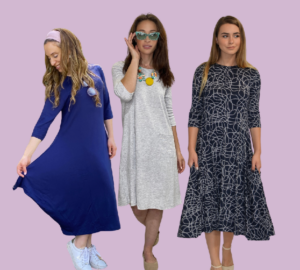
- Hourglass Body Type:
- Characteristics: Balanced bust and hip measurements; well-defined waist; proportional shoulders and hips.
- Styling Tips: Highlight the waist with fitted clothing; wear wrap dresses and belts; opt for tailored pieces that accentuate the natural curves; avoid boxy and shapeless clothing.
- Rectangle (Athletic) Body Type:
- Characteristics: Balanced bust and hips; little definition at the waist; straight body lines; less pronounced curves.
- Styling Tips: Create curves with peplum tops and dresses; use belts to define the waist; wear ruffles and patterns to add volume; choose high-waisted pants and skirts.
- Inverted Triangle (Apple with Broad Shoulders) Body Type:
- Characteristics: Broad shoulders; narrower hips; fuller bust; slim legs.
- Styling Tips: Balance the upper body with darker colors and simple necklines; add volume to the lower body with flowing dresses and A-line skirts; avoid shoulder pads and embellishments on the shoulders.
Everyone’s body is unique. Avoid comparing yourself to others, especially those on social media. Focus on your strengths and embrace your individuality. By considering your body shape, you can select modest clothing that flatters your figure and enhances your overall look. The key is to dress in a way that makes you feel comfortable and confident.

by Kosher Casual Team | Jul 14, 2024 | Apostolic Pentecostal, modest clothing, Religious Modesty standards
What is the Difference in Modest Dress Code between Orthodox Jewish and Apostolic Pentecostal Women?
The modest dress codes for women amongst Orthodox Jews and Apostolic Pentecostals share a common commitment to covering the body, but they differ in specific practices and interpretations influenced by their respective religious observances and traditions.
Orthodox Judaism reflects a desire to maintain humility and respect in appearance, adhering closely to interpretations of Jewish law (Halacha) regarding dress and personal conduct. There is an emphasis is on avoiding tight or revealing clothing.
Pentecostals emphasize external reserve as a reflection of inner spirituality and separation from worldly influences Dress standards are often articulated by church leadership and vary somewhat among different congregations.
Clothing:
Orthodox Jewish women typically wear long skirts or dresses that cover the knees. The clothing also covers the elbows and collarbones, often with sleeves extending to the wrists. Necklines are kept above the collar bone and low cut clothing is avoided.
Apostolic Pentecostal women typically wear dresses or skirts that extend below the knees. Pants or shorts are generally avoided due to understandings of religious standards. Sleeves are often longer, covering at least shoulders or elbows. Cleavage cover is encouraged.
Hair Covering:
Most Orthodox Jewish women typically cover their hair after marriage. This can be done using wigs (Sheitels), scarves (tichels), hats, or snoods. The type of hair covering differs by community. Unmarried women do not cover their hair.
In some Apostolic Pentecostal communities, women might choose to cover their hair with a scarf or other head covering during prayer, worship services, or other religious ceremonies. This Apostolic Pentecostal women may wear head coverings more broadly as a sign of submission to their spouse, religious leaders and God.
Cultural Influence and Flexibility:
Orthodox Jewish Women: Dress code can vary significantly based on the specific community (e.g., Hasidic, Yeshivish, Modern Orthodox, and Israeli National Religious), level of religious observance and the cultural subsets of Western Ashkenazi Jews and Eastern Sephardic Jews.
Apostolic Pentecostal Women: Generally adhere to a more uniform standard of dress across different congregations, with similarities in practice. Southern states tend to be more conservative, while Western and Northeastern states might incorporate more contemporary elements. Northern and Midwestern states often find a balance between these extremes.
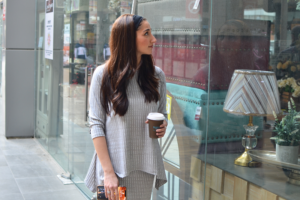
Adornment:
Orthodox Jewish Women: There are no specific prohibitions against makeup or jewelry, although more conservative communities may discourage excessive adornment.
Apostolic Pentecostal Women: Avoid makeup and jewelry entirely, emphasizing a natural and simple appearance.
Body Modification
Both Orthodox Jewish and Apostolic Pentecostal Women do not allow tattoos!
Interestingly both groups use the same biblical reference from Leviticus 19:28: “You hall not make gashes in your flesh for the dead, or incise any marks on yourselves: I am the Lord.” This verse explicitly prohibits the practice of making permanent marks on the body.
In summary, while both Orthodox Jewish and Apostolic Pentecostal women adhere to similar modesty standards in dress, there are some variations in hair coverings and accessories. Each group follows the specific teachings and interpretations of Torah/Bible/Scriptural, the practices of local and regional traditions, and in sometimes distinct cultural backgrounds.

by Kosher Casual Team | Jul 14, 2024 | Budget, Modest, modest clothing
How to Dress Modestly On A Budget!
Dressing modestly doesn’t need to be expensive. Saving money on clothes can be done by careful planning and smart shopping habits. Here are some practical tips to help you save money on clothing purchases:
- Create a capsule wardrobe of neutral basics: Since neutral pieces work well together, you can create a wide range of looks with fewer items reducing the need to buy additional clothing. With a capsule wardrobe, Instead of buying random items, you focus on acquiring versatile, timeless pieces that can be worn for multiple seasons and occasions.
- Shop Online: Online shopping can offer a wider selection of modest clothing options at various price points. Look for online retailers that offer free shipping or discounts on your first purchase to save even more money.
- Sign Up for Email Lists: Subscribe to the email lists of your favorite clothing brands and retailers. Many companies offer exclusive discounts and promotions to subscribers, so you can save money on your purchases.
- Use Loyalty Rewards Programs: Take advantage of email rewards programs for modest clothing. Many credit cards, websites, and apps offer cashback or points for purchases, which can help you save money on future purchases.

- Buy Mix-and-Match Pieces: Invest in mix-and-match pieces that can be styled in multiple ways to create different outfits. This will allow you to maximize your wardrobe without having to buy a lot of new clothing items.
- Shop Off-Season: Look for clothing items during off-season sales. Retailers often discount clothing at the end of each season to make room for new inventory. You can find great deals on modest pieces by searching for winter clothing in the spring or summer clothing in the fall.
- Consider Secondhand Options: Explore thrift stores, consignment shops, and online marketplaces for secondhand modest clothing. You can often find gently used items at a fraction of the cost of new clothing.
- Clothing Swaps: Consider organizing or participating in clothing swaps with friends, family, or community members. This is a great way to refresh your wardrobe without spending any money by exchanging gently used clothing items.
Remember to prioritize quality and versatility when building your modest wardrobe, and don’t be afraid to get creative with your bargain hunting strategies! By following these shopping tips, you can find modest clothing options that are fashionable and stylish without breaking the bank.
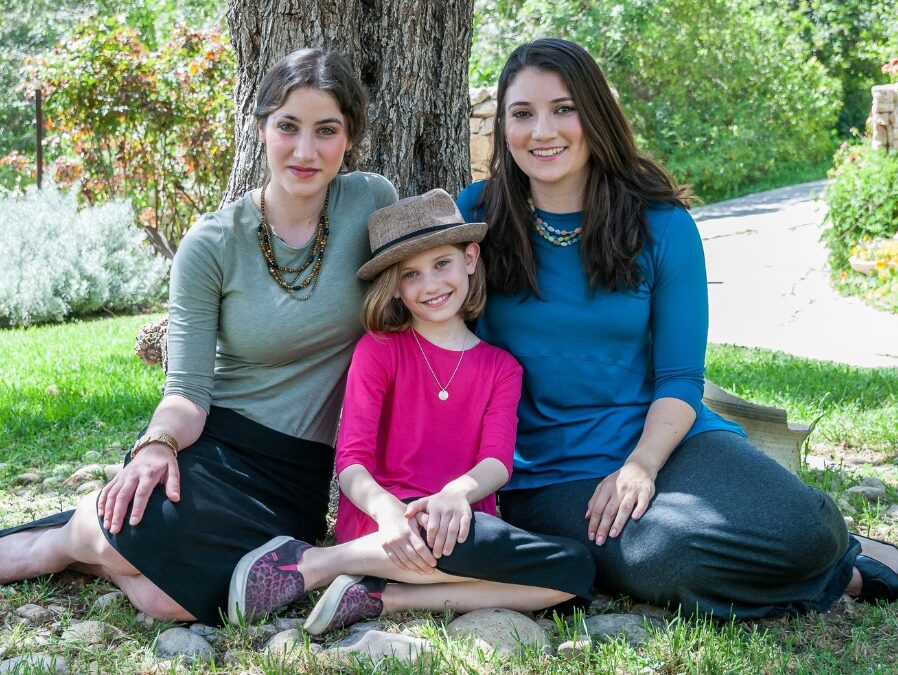
by Kosher Casual Team | Jul 14, 2024 | modest clothing, Modest Dresses, Modest Fashion, Religious Modesty standards
How to Teach Girls to Dress Modestly!Teaching girls make clothing choices that are respectful, appropriate for various settings, and aligned with societal values in today’s world is not always easy. We want to prepare our children for a world where external appearances can influence perceptions. Here are some strategies for teaching girls to dress modestly:
Start Early: Begin teaching girls about appropriate clothing choices from a young age. Even children as young as three can understand simple concepts as they learn to dress themselves.
Explain the Reasons: Help girls understand why the way we dress is important and how it contributes to their self-respect, dignity, and relationships with others. Talk about how your religious beliefs, culture, environment and values. It is crucial in navigating these discussions to foster open and honest communication.
Set Clear Guidelines: Establish clear guidelines for appropriate attire in different settings, such as at home, school, religious gatherings, and social events. Offer them guidance on selecting clothing items that provide adequate coverage and are respectful of their bodies.
Encourage Self-Expression: Allow girls to express their personal style and preferences within the boundaries of what’s acceptable. Encourage them to choose clothing that reflects their individuality while also respecting cultural norms and social expectations.
Teach Dress Codes: Familiarize girls with dress codes at their school, religious institution, or other places they frequent. Help them understand the reasons behind these dress codes and how to comply with them while still expressing some individuality.
Provide Feedback: Offer constructive feedback and guidance when girls are selecting clothing or putting together outfits. Encourage them to consider factors such as fit, length, shirt necklines, and overall coverage when making clothing choices. 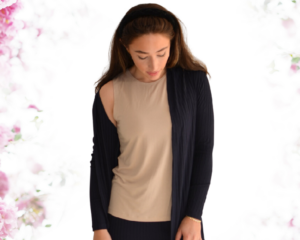
Be a Role Model: Lead by example with your own clothing choices and behavior. Girls often learn from their mothers. Teach your daughters to dress with confidence and self-assurance.
Discuss Media Influence: Talk to girls about the influence of media, fashion trends, and peer pressure on clothing choices. Help them develop critical thinking skills to navigate messages about beauty, body image and self-worth in the media.
By incorporating these strategies into your parenting approach, you can help girls develop a sense of modesty and make respectful clothing choices that reflect their values, individuality, and self-respect.
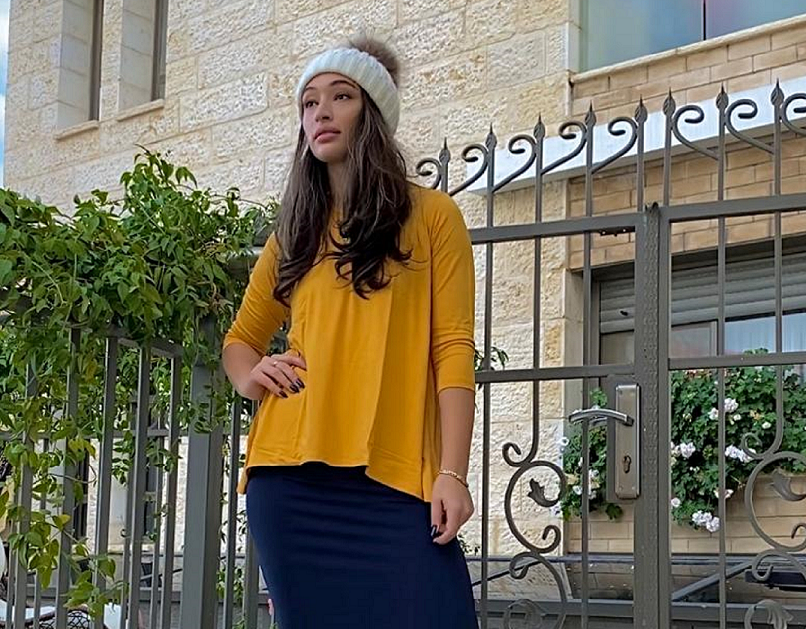
by Kosher Casual Team | Feb 5, 2024 | modest clothing, Pencil Skirts, Tunic Tops
Adding pops of color to modest clothing can be a delightful way to express your personal style while maintaining coverage. Here are some suggestions for infusing vibrant hues into your modest wardrobe:
Bright Accessories:
Use accessories like colorful belts, exotic print scarves, or statement jewelry to introduce shiny metals and vibrant jewel tones to glam up your outfits. Wear a cuff bracelet or a set of stacked bracelets on one wrist. Even small accessories can add a touch of glamour without being overwhelming.
Contrast Colors Outfits:
Create visually interesting outfits by color-blocking with opposing colors on the color wheel. Pair yellow with navy, coral with turquoise, green and reds, etc., pairing them together for a modern and modest look.
Combine Pattern and Textures
If you’re comfortable with it, mix subtle patterns and textures in the same color shades and hues. For example, pair a ribbed baby blue top with a navy plaid skirt, consequently the colors will complement each other.
Layered Color:
Experiment with layering different colored pieces. For example, you can layer a colorful long-sleeved cardigan over a crisp white shirt or neutral blouse. Pair neutral-colored clothing items with one or two vibrant pieces. Generally feel free to experiment with different color combinations to discover what resonates with your personal style.
Print Blouses or Tunics
Buy three quarter tops or tunics in bold print patterns that can be paired with skirts or trousers for a chic and colorful look. Choose trendy animal, tie dye or ethnic prints for a modest and lively look.
Embellished Footwear
Choose flats, heels or boots with embellishments, such as studs, embroidery, or metallic details, to add a dash of style to your footwear. However avoid bright colors as these may overpower the rest of your outfit.
Colored Hats or Headscarves
If you cover your hair, choose bright colors in various shades to add a pop of color to your outfit. Adding color can add an element of fun or in a formal setting an elegant stylish accessory. Coordinating colors with one item in your outfit provides a nice intentional and cohesive appearance.
Remember that personal style is subjective, and these suggestions are just a starting point. Feel free to mix and match these ideas based on your preferences and the occasion. The key is to add elements that make you feel especially confident and express your unique style while maintaining modesty.
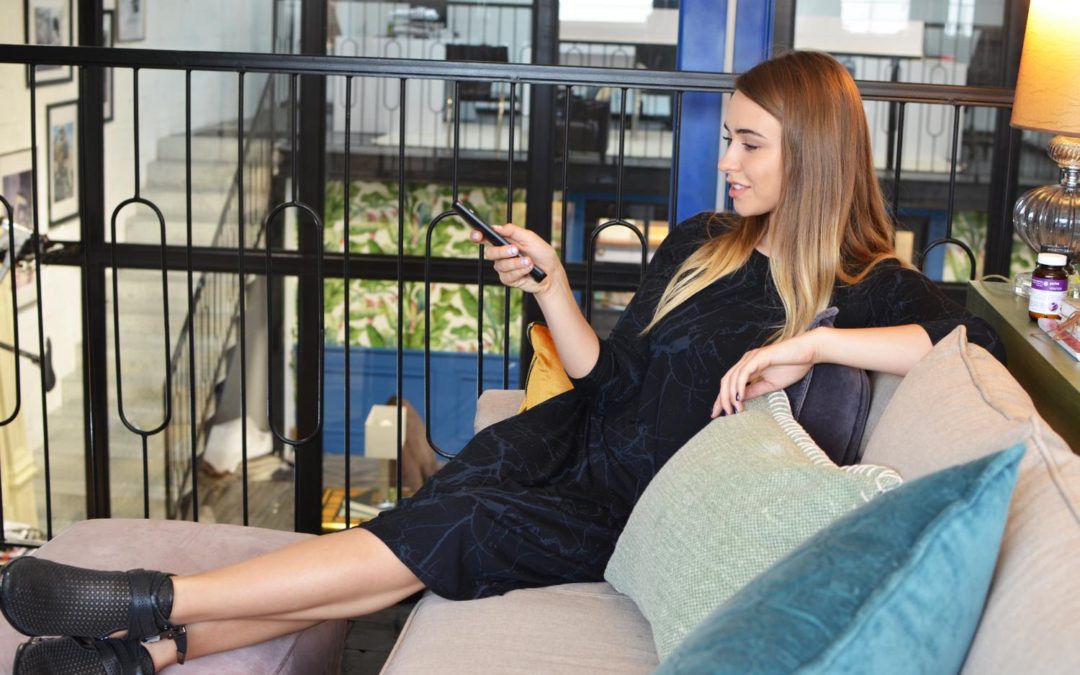
by Kosher Casual Team | Jul 17, 2023 | Fashion Philosophy, Kosher Casual, modest clothing, Modest Clothing Accessories
Absolutely! You can definitely look cute and attractive without appearing immodest. Being stylish and appealing doesn’t require revealing too much skin or compromising your personal values. Here are some tips to help you achieve a cute and sexy look while maintaining modesty. Embrace your personal style. Find clothing that complements your body shape and makes you feel confident without relying on revealing attire. Everyone has different preferences, so choose outfits that reflect your personality and comfort level.
- Opt for flattering cuts: Clothing that fits well and accentuates your best features can be attractive without showing too much. Tailored outfits can be just as alluring as revealing ones, if not more so.
- Pick the right neckline: High necklines, boat necks, or scoop necks can be elegant and attractive while still covering the décolletage.
- Choose the right length: Opt for dresses, skirts, and shorts that are flattering to your body type. The hemline can hit at the knee or longer to strike a balance between style and modesty.
- Pay attention to fabric: Choose fabrics that drape well and have a flattering silhouette without being overly revealing. Flowy fabrics can create an alluring look without showing too much skin.
- Play with accessories: Accessories can enhance your overall look. Statement jewelry, scarves, or hats can add a touch of personality and style to your outfit.
- Experiment with colors: Vibrant colors can make you stand out and exude confidence without resorting to immodest attire.
- Balance form-fitting with loose-fitting: If you prefer form-fitting clothing, consider pairing it with a looser item to create a balanced and sophisticated look.
- Wear appropriate undergarments: Ensure that you wear appropriate undergarments that provide coverage and support to avoid any accidental exposure.
- Emphasize your best features: Showcasing your favorite features tastefully can add an attractive touch to your outfit. For example, if you like your shoulders, wear a one-shoulder top, or if you love your waist, choose a belted dress.
Remember, confidence is key. When you feel comfortable and confident in your clothing choices, it will naturally reflect in your overall appearance, making you look cute (and even sexy) without compromising your modesty.












